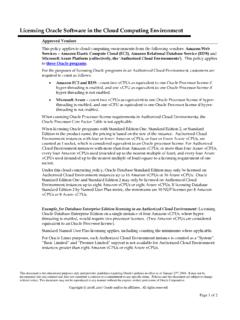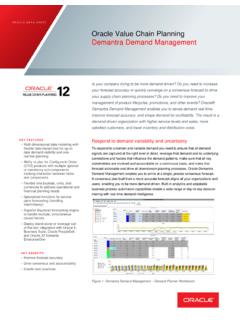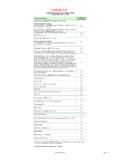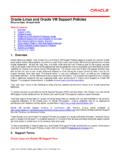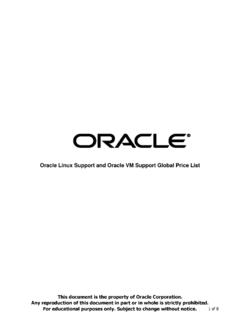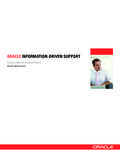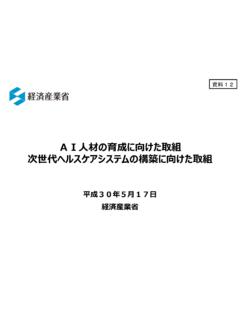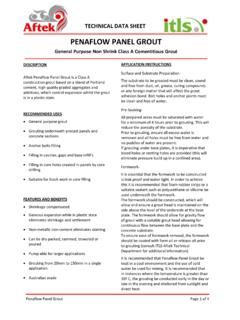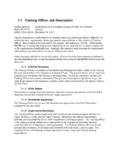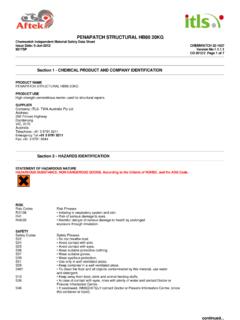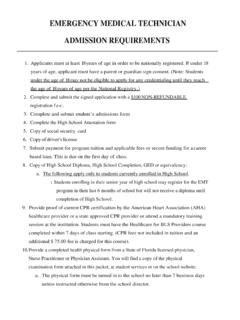Transcription of Data Guard Redo Apply and Media Recovery Best …
1 oracle Database 10g best Practices: Data Guard Redo Apply and Media Recovery An oracle White Paper September 2005 oracle Database 10g best Practices: Data Guard Redo Apply and Media Recovery Page 2 oracle Database 10g best Practices: Data Guard Redo Apply and Media Recovery Executive Overview .. 3 Data Guard Redo Apply and Media Recovery best Practices .. 4 Tuning Media Recovery 4 best Practices for Tuning Log Read 5 best Practices for Tuning Redo Apply 5 best Practices for Tuning Checkpoint 8 Troubleshooting and Advanced Tuning .. 9 Assess system 9 Assess database waits .. 10 Conclusion .. 12 Appendix A Recovery Rate Script .. 13 Appendix B Recovery tuning 14 References ..16 oracle Database 10g best Practices: Data Guard Redo Apply and Media Recovery Page 3 oracle Database 10g best Practices: Data Guard Redo Apply and Media Recovery EXECUTIVE OVERVIEW With the increasing adoption of oracle Data Guard as a comprehensive solution for enterprise disaster Recovery , optimizing Media Recovery for Data Guard Redo Apply is an important consideration for a Data Guard configuration, in order to keep the physical standby in that configuration as current as possible with the primary database.
2 Media Recovery occurs when one or more datafiles or the controlfiles are restored from a previous backup or when using Data Guard Redo Apply in managed Recovery . The goal of Media Recovery is to recover the datafiles and the rest of the database to a consistent point in time or to Apply all primary database transactions that have occurred when a physical standby database is used to protect the primary site. This paper provides best practice recommendations for configuring Media Recovery in oracle Database 10g both in the case of a regular backup and Data Guard Redo Apply , such that the Service Level Agreement (SLA) associated with the Recovery time can be achieved 1. This paper does not cover block Media Recovery , crash Recovery , instance Recovery , or Data Guard SQL Apply with a logical standby database.
3 It may be noted that with some of the new features of oracle Database 10g, such as Real Time Apply and Flashback Database, Data Guard Redo Apply can provide fast switchover or failover in the event of an outage while still being prepared to revert any logical corruption. It is essential that Media Recovery is tuned by following the best practices outlined in this paper so that it complements these new features in the most optimal manner. Based on test results and customer experiences, following are examples of results obtained after adopting the best practices outlined in this paper: In oracle Database 10g, the Data Guard Redo Apply instance achieved an Apply rate of 14 MB/sec for a large OLTP application. 1 This SLA metric is commonly referred to as the Recovery Time Objective (RTO).
4 oracle Database 10g best Practices: Data Guard Redo Apply and Media Recovery Page 4 Data Guard Redo Apply doubled redo Apply rate in oracle Database 10g compared to Oracle9i. In an environment with 8 CPUs (@400 Mhz) and 8 GB RAM, redo Apply rate improved from 6 MB/sec in Oracle9i to 14 MB/sec after upgrading to oracle Database 10g. DATA Guard REDO Apply AND Media Recovery best PRACTICES The best practices outlined in this paper have been derived after extensive Media Recovery testing on oracle Database 10g as part of performance studies within the Maximum Availability Architecture (MAA) project2. For more information on MAA, please refer to [1]. For more information on oracle 10g High Availability Practices or Data Guard , refer to [2], [3], [4] and [5]. Besides, some of these best practices were derived after extensive joint studies with real customer databases.
5 Tuning Media Recovery Phases Media Recovery consists of three distinct phases. Each phase must be assessed and tuned if the Recovery rate is not sufficient. 1. Log Read Phase involves the reading of redo from the standby redo logs or archived redo logs by the Recovery coordinator or Managed Recovery Process (MRP). 2. Redo Apply Phase involves the reading of data blocks into the buffer cache and the application of redo, by parallel Recovery slave processes. The Recovery coordinator (or MRP) ships redo to the Recovery slaves using the parallel query (PQ) inter-process communication framework. 3. Checkpoint Phase involves the flushing to disk of modified data blocks and the update of data file headers to record checkpoint completion. Real Application Clusters (RAC) provides additional fault tolerance to an existing Data Guard Redo Apply instance but does not help speed up Recovery .
6 For a RAC standby, in Data Guard Redo Apply , Media Recovery still runs on one instance, called the Apply instance. However, for a RAC standby, Data Guard Broker makes it possible to achieve seamless high availability in the event of failures of one or more instances in a RAC standby. Redo transport and redo Apply can be redirected to a surviving standby instance without any intervention from the user. For further details, refer to [6]. The following sections outline the best practices relevant to each phase. 2 These general best practices should Apply to most customer environments. However, these results are not indicative of what you may experience. Testing with serial Recovery and different degrees of parallelism is imperative.
7 oracle Database 10g best Practices: Data Guard Redo Apply and Media Recovery Page 5 best Practices for Tuning Log Read Phase Maximize I/O rates on standby redo logs (SRL) and archived redo logs Measure read I/O rates on the SRL and archived redo log directories. Keep in mind that the concurrent writing of shipped redo on a standby may reduce the redo read rate due to I/O saturation. The overall Recovery rate will always be bounded by the rate at which redo can be read; so ensure that the redo read rate surpasses your required Recovery rate. The following UNIX example shows how to measure the maximum redo read rate for Recovery . oracle uses a 4 MB read buffer for redo log % /bin/time dd if=/redo_ of=/dev/null bs=4096k 50+1 records in 50+1 records out real user sys Estimated Read Rate (200 MB log file) = (50 * 4 MB) / = MB/sec best Practices for Tuning Redo Apply Phase Assess Recovery Rate Use the following queries to get several snapshots while a redo log is being applied to obtain the current Recovery rate: i) Determine Log Block Size (lebsz) since it is different for each operating system.
8 This query only needs to be executed once. select lebsz LOG_BLOCK_SIZE from x$kccle where rownum=1; ii) Derive Recovery blocks applied for at least 2 snapshots: (a) Media Recovery Cases ( recover [standby] database) select TYPE, ITEM, SOFAR, TO_CHAR(SYSDATE, DD-MON-YYYY HH:MI:SS ) TIME from v$RECOVERY_PROGRESS where ITEM= Redo Blocks and TOTAL=0; (b) Managed Recovery Cases ( recover managed standby ) select PROCESS, SEQUENCE#, THREAD#, BLOCK#, BLOCKS, TO_CHAR(SYSDATE, DD-MON-YYYY HH:MI:SS ) TIME from V$MANAGED_STANDBY where PROCESS= MRP0 ; 3 If you repeat this simple test, use a different SRL or archive log since the data may be cached making the results artificially high and incorrect. oracle Database 10g best Practices: Data Guard Redo Apply and Media Recovery Page 6 iii) To determine the Recovery rate (MB/sec) for this archive, use one of these formulas with the information derived above: (a) Media Recovery Case: ((SOFAR_END SOFAR_BEG) * LOG_BLOCK_SIZE) / ((TIME_END TIME_BEG) * 1024 * 1024 ) (b) Managed Recovery Case: ((BLOCK#_END BLOCK#_BEG) * LOG_BLOCK_SIZE)) / ((TIME_END TIME_BEG) * 1024 * 1024) To assess if more tuning is required, get the maximum and average redo generation rates at the primary database from the primary database s v$sysstat s statistic redo size 4 and use the redo Apply rate quick assessment chart below.
9 Table 1: Redo Apply Rate Quick Assessment Redo Generation Rate vs Redo Apply Rate Recommendation 2 * Max Primary Database Redo Generation Rate < Redo Apply Rate Excellent - No Tuning Required Max Primary Database Redo Generation Rate < Redo Apply Rate < 2 * Max Primary Redo Generation Rate Good - Tuning is Optional Avg Primary Redo Generation Rate < Redo Apply Rate OK - Need Tuning Avg Primary Redo Generation Rate > Redo Apply Rate Bad - Need Tuning. Call oracle Technical Support if all tuning steps have been followed and the redo Apply rate is still too slow. Refer to Appendix B. You may notice that the Recovery rate may vary depending on the primary s transaction activity. Typically Recovery rate is much higher when the number of distinct blocks being changed is small or during batch processing.
10 In most applications, a predictable pattern surfaces after monitoring for several days. 4 You can derive the Redo Generation Rate manually by querying v$sysstat and getting 2 snapshots. The formula of Redo Generation Rate: ( size size)/time interval You can leverage the following query to get a snapshot of redo size: select name, value, to_char(sysdate, dd-mon-yyyy HH:MI:SS ) from v$sysstat where name = redo size ; oracle Database 10g best Practices: Data Guard Redo Apply and Media Recovery Page 7 Please refer to the Recovery rate script in Appendix A. Use defaults for DB_BLOCK_CHECKING and DB_BLOCK_CHECKSUM The default settings are DB_BLOCK_CHECKING = FALSE and DB_BLOCK_CHECKSUM = TRUE. Setting DB_BLOCK_CHECKING to TRUE can potentially halve the Recovery rate.
